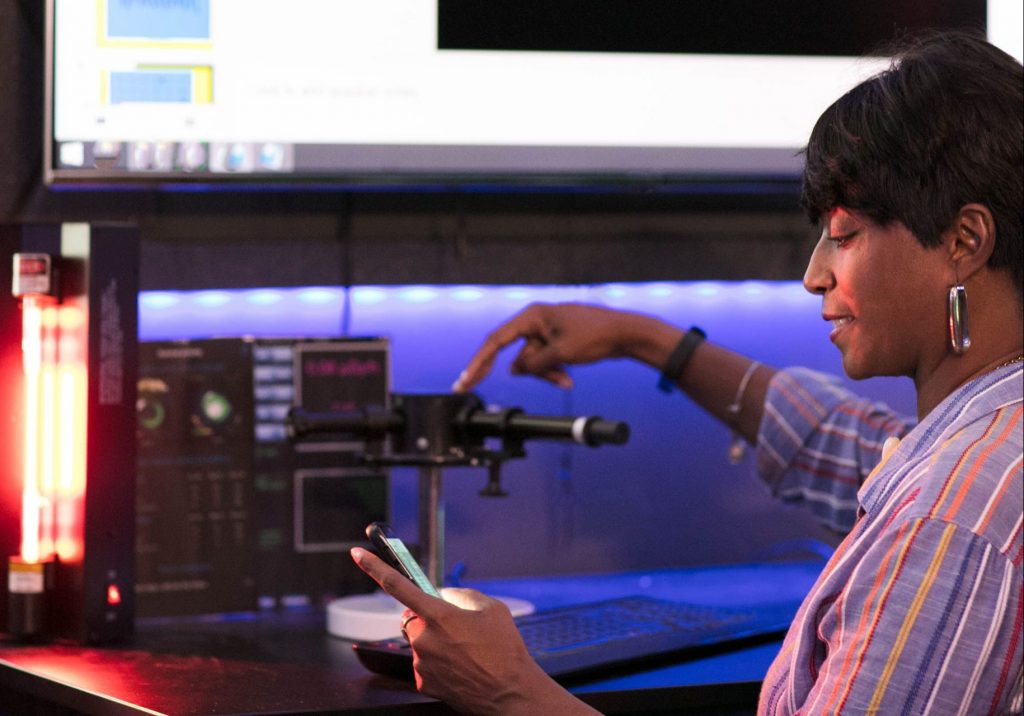
In the NASA STEAM Innovation Lab, scientists, engineers, and educators are exploring how to use robotics in education. Robotics are extremely common in the work that NASA does, because robots can do things that humans cannot. This includes exploring faraway places or conducting dangerous work. From robotic arms to rovers, robots are only becoming more vital to NASA’s missions. This new Exploration Idea Profile shows how LEGO and VEX robots can mimic NASA robotics.
With the integration of affordable sensors to explore temperature, navigation, and the positions of small objects, these small-scale robotic sensors can mirror similar sensors used in NASA missions, such as thermocouples, resistance temperature detectors (RTD), and global positioning system (GPS) used in NASA’s MMS spacecraft.
“There are thousands of robots that make space exploration possible. As robots continue to evolve, they are at the forefront of space exploration,” Leslie Garrison, NASA MMS Mission Sr. Outreach Coordinator and Team Lead of this Exploration Idea Profile, says. “Many scientists believe robots, not humans, will make the next great discoveries in space. I believe if we can get students inspired, engaged, and educated we can eventually employ them. A great start would be the NASA internship opportunities and research programs for both high school and college students.”

The people who work in the NASA STEAM Innovation Lab want to make sure that the technology they’re exploring is not only connected to technology in NASA missions, but also connected to the education students receive in our school systems.
“Robotics education is becoming increasingly commonplace in schools. This is largely due to the fact that students will graduate into a workforce with plentiful technology, in an era where robots will become widely used in our everyday lives,” Leslie explains. “It’s clear that the United States needs more highly-skilled STEAM workers to remain globally competitive. And STEAM education – including trained STEAM teachers – is critical to that goal. Learning robotics teaches students many important skills, such as analytical thinking, programming, teamwork, collaborative thinking, innovation, and more.”
Robotics provides numerous technologies that support STEAM education. In addition to being fun, robots engage beginners and advanced students, as well as incorporate many of fundamental STEAM concepts, providing a learning platform that students enjoy. By teaching robotics, educators can prepare today’s students for tomorrow’s workplace, however many students are learning from home right now. Since kits can be low cost and many don’t require a background in programming, kids and adults alike can begin exploring robotics.
Leslie says, “Whether students aspire to become an astronaut, engineer, computer programmer, scientist, or one of the hundreds of other STEAM career options, they need a foundation in coding and the design process. There are many robotics kits for children as young as 5 years old to learn robotics and coding with very simple challenges and projects. Parents can teach their children with numerous easy to use online lessons that include videos and step-by-step instructions for coding and engineering concepts.”
Leslie and the NASA STEAM Innovation Lab are excited to share this new profile with you. We’d love to hear your ideas for using robotics to explore educational technology. Leave your thoughts in the comments below! You can see the new profile here and see the latest Dispatch with a note and extended ideas from Leslie.
“I am excited to explore and create unique opportunities for students/youth to contribute to NASA’s work in exploration and discovery,” Leslie says. “I’d like to further provide ways to support youth/students and teachers of color in robotics education. By engaging students in authentic learning experiences with NASA people, content, and facilities we have the opportunity to build a diverse future STEAM workforce.”
To subscribe to the NASA STEAM Innovation Lab Dispatch and get the latest from the lab straight to your inbox, sign up here.
